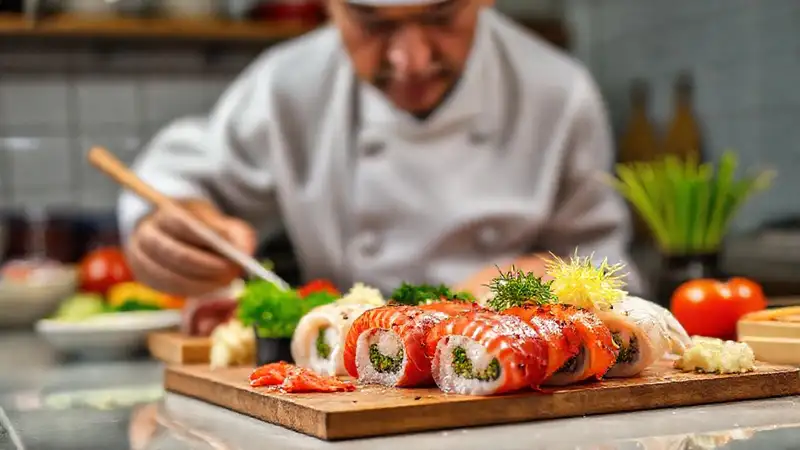Japanese sushi has become a globally beloved culinary experience, transcending simple food to become a symbol of refinement and artistry. Its popularity isn't simply due to taste; it’s rooted in a deeply ingrained philosophy of using the freshest ingredients and respecting the inherent beauty of nature. However, replicating those authentic flavors and textures can be challenging outside of Japan. Achieving that delicate balance of umami, freshness, and subtle seasoning requires careful attention to detail. This guide will delve into the key components and techniques crucial for crafting sushi that captures the essence of this iconic Japanese dish.
The magic of sushi lies not just in the rice, but in the synergy between all the elements: the fish, the vinegared rice, and the seasonings. It’s a complex interplay of textures, temperatures, and flavors, demanding a deep appreciation for Japanese culinary traditions. Understanding the preparation methods and ingredient sourcing will dramatically improve your attempts to recreate the genuine Japanese sushi experience, moving beyond a simple imitation to a true homage.
Nigiri: The Foundation of Flavor
Nigiri, perhaps the most recognizable form of sushi, comprises a slice of fish draped over a small oblong mound of vinegared sushi rice. The quality of the fish is paramount; it should be incredibly fresh, almost glistening, and possess a pronounced, clean flavor. Beyond this, the rice is crucial. It needs to be perfectly seasoned with sushi-zu, a vinegar mixture comprised of rice vinegar, sugar, and salt – the proportions carefully calculated to provide a slightly tangy, subtly sweet flavour. Traditionally, a tiny amount of wasabi is applied directly to the fish before it’s placed on the rice.
The technique involves gently pressing the fish onto the rice, ensuring a slight compression that allows the flavors to meld. The goal is to create a cohesive bite, where the rice doesn't separate from the fish. Experimenting with different types of fish, each boasting its own unique profile – from the rich fattiness of tuna to the delicate sweetness of sea bream – is key to developing a nuanced understanding of nigiri. Remember, presentation is just as important as taste; a careful, deliberate placement of the fish elevates the entire experience.
Furthermore, using high-quality shari (sushi rice) is non-negotiable. Proper grain structure, a slightly sticky texture, and a gentle warmth are essential for achieving the ideal mouthfeel. Don’t overcook the rice, as this will result in a mushy and unappealing texture. Maintaining a consistent temperature during preparation and serving is also vital for replicating the authentic Japanese experience.
Maki: Rolls of Art and Texture
Maki, or sushi rolls, offer a greater versatility in terms of ingredients and shapes. Unlike nigiri, the ingredients are enveloped within a sheet of nori seaweed, creating a protective layer and a distinctive textural contrast. The rice here must be firmer than for nigiri, as it's compressed to hold the roll together. Adding a small amount of water to the rice before pressing helps bind it.
There are numerous styles of maki, from hosomaki (thin rolls) to futomaki (thick rolls), each with its own specific character. Classic fillings include cucumber, avocado, crab, and tuna. Consider adding a small amount of sesame seeds or a drizzle of spicy mayo for added flavor and visual appeal. The key to a well-executed maki roll is applying even pressure while rolling; avoid pressing too hard, which can cause the nori to tear and the rice to become compacted.
Don’t forget the importance of chilling the rolls before slicing. Chilling sets the rice and makes it easier to cut cleanly. Use a very sharp, wet knife to slice the rolls, wiping the blade frequently to prevent the rice from sticking. The result should be neat, even slices that showcase the beautiful combination of ingredients within each roll.
Sashimi: Celebrating the Fish’s Essence

Sashimi, simply translated as “slices of fish,” highlights the fish itself – its texture, flavour, and colour. It’s presented without rice, emphasizing the pure, unadulterated taste of the seafood. As with nigiri, freshness is absolutely critical; sashimi must be incredibly fresh, almost translucent, and possess a vibrant, natural colour.
The selection of fish is a crucial aspect of preparing sashimi. Each species offers a unique flavour profile, ranging from the buttery richness of salmon to the delicate sweetness of yellowtail. Thinly slicing the fish with a sharp knife is essential to achieving a delicate texture. Traditional Japanese knives are preferred for this purpose. Pay close attention to the grain of the fish; slicing with the grain yields a more tender bite.
Traditionally, sashimi is served with a mere touch of soy sauce and wasabi. Avoid drenching the fish in sauce, as this can mask its natural flavors. A dab of wasabi adds a subtle heat and complements the delicate taste of the fish beautifully. Simple, elegant presentation is key – let the quality of the fish speak for itself.
Temaki: A Casual and Creative Twist
Temaki, or hand rolls, offer a more informal and creative approach to sushi. These cone-shaped rolls are made by hand, allowing for greater personalization and experimentation. Start with a sheet of nori, place a small amount of seasoned rice at the base, and then add your desired fillings – fish, vegetables, and sauces.
Rolling the nori into a cone and securing it with a bamboo mat (makisu) is the simplest method. Experiment with different fillings to create unique flavor combinations. Some popular choices include shrimp tempura, avocado, cucumber, and spicy tuna. The beauty of temaki lies in its adaptability; there are no strict rules or guidelines – feel free to get imaginative!
While temaki can be more casual, maintaining the same principles of freshness and careful construction is still important. Ensure the rice is properly seasoned and that the fillings are evenly distributed. Serving temaki with a dipping sauce and a small plate of wasabi elevates the experience and demonstrates respect for the tradition, even in a more relaxed format.
Conclusion
Replicating authentic Japanese sushi flavors is a rewarding journey that demands respect for tradition and a keen attention to detail. It’s more than just assembling ingredients; it's about understanding the nuances of each component and the subtle interactions that create the overall experience. By prioritizing freshness, mastering the techniques for preparing the rice, and experimenting with different fish and fillings, you can significantly improve your sushi-making skills.
Ultimately, the key to success lies in genuine appreciation for the art of sushi. Continuously refine your skills, seek inspiration from experienced chefs, and embrace the philosophy of mottainai – avoiding waste and valuing every ingredient – to unlock the secrets of creating truly remarkable sushi at home. Don’t be afraid to experiment and adapt, but always hold true to the core principles of quality and respect for the heritage of this incredible cuisine.
 How does Kansai sushi relate to local markets
How does Kansai sushi relate to local markets How does Tokyo’s sushi emphasize freshness, always
How does Tokyo’s sushi emphasize freshness, always How does the seasonality affect Kansai sushi
How does the seasonality affect Kansai sushi What are the traditional seasonings in Kansai sushi
What are the traditional seasonings in Kansai sushi How does Hokkaido’s connection to agriculture help
How does Hokkaido’s connection to agriculture help What are some unconventional additions to frittura mista
What are some unconventional additions to frittura mista What makes Tokyo’s sushi a celebrated art form
What makes Tokyo’s sushi a celebrated art form
Deja una respuesta